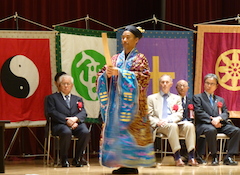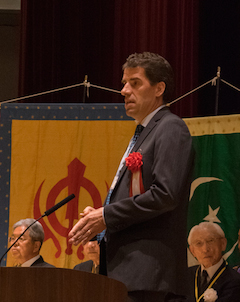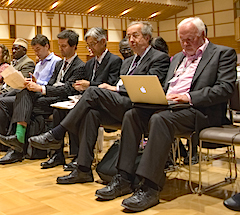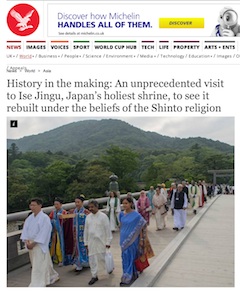| |
|
 |
Church Times and Independent both hail Ise agenda
July 1 2014:
 |
 |
 |
Tradition for the Future - ancient values addressed modern problems at Ise |
The international event organised by ARC and Jinja Honcho, the Association of Shinto Shrines has been the subject of thoughtful press coverage in two UK major publications: The Church Times and The Independent. The longer Independent piece, covers three pages and reflects both the significance of the event for Shintoism itself as well as the conference’s theme of engaging religions as important allies for the 2015 UN Millennium Development Goals programme.
History In The Making: The Independent newspaper
By Paul Vallely
Under the double-barred gateposts, by the entrance to the bow-backed bridge, a solitary figure was waiting. He was white-robed and bare-headed. He was about to make history.
The Shinto priest bowed deeply to the group of men and women who approached the most venerated shrine in Japan. They, too, were enrobed – in the rich gold-embroidered red and blue of Chinese Taoism, in glorious Hindu saris, in simple white Islamic tunics and shifts, in bright yellow Sikh scarves and turbans, in the austere cassocks of Scandinavian Lutherans, the cream vestments of African Catholics and the black and red academic robes of American Baptists.
At any time in the past 2,000 years, the job of the Shinto guardian of the Hiyokebashi bridge would have been to prevent such aliens from entering this holiest of Japan’s sacred places. But now he bowed deeply, twice, and welcomed them to enter.
 |
 |
 |
'Inspiring' - UN Deputy Secretary General Olav Kjørven addressing the Ise meeting |
History was made at Ise Jingu in many ways this month. The ancient shrine has been completely rebuilt from new wood, as it has been every 20 years since the seventh century. The rebuilding has attracted a record 14 million visitors. Yet that is only part of a remarkable resurgence of Japan’s ancient religion of Shintoism, which, in the decades after the Second World War, had reached a low point unprecedented in its 3,000-year history.
That revival has produced a new Japanese openness to the wider world. It has welcomed in representatives of the faiths of foreigners including even the Confucians and Taoists of the two great religious traditions of Japan’s historical enemy, China. Shintoism this month also hosted the first international conference in its entire history. And it has developed a new attitude to a world threatened by climate change and environmental degradation.”
Read the whole article
A UN conference has asked for input on goals from faith groups, says Paul Vallely in The Church Times
IT WAS a conference of almost all the world's main religions. There were Daoists and Confucians from China, Muslims from Indonesia and England, Hindus and Sikhs from India, Buddhists from Sri Lanka, Lutherans from Scandinavia, Baptists from the United States, Anglicans and Roman Catholics from Africa, and Shinto priests from Japan. Yet the two most inspiring speeches came from secular figures.
Earlier this month, I was in Ise, a Shinto shrine in Japan, for a conference at which the United Nations had invited faith input into the shaping of the Sustainable Development Goals, which, the UN hopes, will take over as a new international benchmark when the Millennium Development Goals (MDGs) expire at the end of 2015.
Keynote speeches were given by two outsiders. Olav Kjørven, the UN's Assistant Secretary-General, began by asking the religious leaders what got them up in the morning. "This is the kind of question we don't generally ask at the United Nations," he said. "It's part of the things that we lose sight of." The MDGs had been drafted by technocrats and economists whose focus was materialist. But, if the world was to survive, it needed some new yardsticks, which embodied deeper spiritual values.
 |
 |
 |
Paul Vallely (right, with laptop) at the Ise event. Beside him are (l-r) Muguluma Hamed (Hear Uganda), Olav Kjørven (UN), Oliver Smith (WWF, ARC Trustee), Yoshiro Sada (MOA, ARC Trustee), and Michael Shackleton (Senior Consultant, ARC) |
The Daoist concept of yin and yang, and the need for balancing the earthly and the heavenly, offered insights into how we should treat the environment, he said. The Sikh tradition of providing food for all, without conditions, could teach us how to address the rising inequalities in the world. St Paul's insistence that "If I have no love, I am but a noisy gong," should be applied to the love of God's creation.
It was ideas, not technology, that would bring about real change in our world, said Ian Johnson, the Secretary General of the Club of Rome - which, 40 years ago, produced the pioneering report The Limits of Growth. "As a world, we are wealthier than we've ever been, and yet we are not providing enough jobs, and two billion people still live in absolute poverty," he said, pointing to several disconnects. "The financial sector has gone its own way, and is not serving the needs of the economy. And our economy has become divorced from our ecology." Both must be reversed.
As proof that values can be more transformative than technologies, he cited three recent examples of change. Attitudes and practices on drink-driving and recycling have altered radically only because of a significant shift in people's value-judgements. "People are now doing the right thing, and for its own sake," he said. He detected the beginning of a similar change on attitudes to the way we waste food. "There's an appetite in society for a new values-based approach on a range of issues. Faith organisations can be crucial in helping to change and raise expectations."
The conference, organised by the Alliance for Religion and Conservation, was named "Tradition for the Future". The challenge is how traditional religious ideas about transcendence, community, service, and self-sacrifice can be reimagined to gain traction in a secular world.
Huffington Post coverage
Deputy Secretary General of the UN, Olav Kjorven also wrote a blog about Ise in the This article was first published in the Huffington Post in July 2014, shortly after Mr Kjørven had addressed the Ise meeting.
 |
 |
 |
How the Independent feature looked on-line |
Can There Be Development Without Spiritual Capital? Article by Olav KjorvenThe headline of this article might sound like an oddity, but hear me out on this. Negotiators at the United Nations are currently debating a new global development agenda under the headings of sustainable development and the eradication of poverty. They are discussing whether things ranging from child nutrition to road safety to violence against women should be part of the new Sustainable Development Goals (SDGs) that will pick up from where the Millennium Development Goals (MDGs) leave us by the end of 2015. It's an expert's dream circus.
But let me offer three quick snapshots to try and convince you that agreeing on shared global development goals, and then actually achieving them, depends on more than expert -- or even market -- solutions. They require a good dose of faith and spirited energy and action.
Read article in full
Useful linksRead the original article on the Independent website
Independent article
ValuesQuest
More about Ise as a shrine
More about the Ise event
|
 |
 |
|
|
|
|
|

